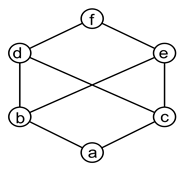Question

a.
non-lattice poset
b.
semilattice
c.
partial lattice
d.
bounded lattice
Posted under Discrete Mathematics
Engage with the Community - Add Your Comment
Confused About the Answer? Ask for Details Here.
Know the Explanation? Add it Here.
Q. The graph given below is an example of _________
Similar Questions
Discover Related MCQs
Q. The graph is the smallest non-modular lattice N₅. A lattice is _______ if and only if it does not have a _______ isomorphic to N₅.
View solution
Q. A directed graph or digraph can have directed cycle in which ______
View solution
Q. Let, D = <A, R> be a directed graph or digraph,then D’ = <A’, R’> is a subgraph if ___________
View solution
Q. The graph representing universal relation is called _______
View solution
Q. What is a complete digraph?
View solution
Q. Disconnected components can be created in case of ___________
View solution
Q. A simple graph can have _______
View solution
Q. Degree of a graph with 12 vertices is _______
View solution
Q. In a finite graph the number of vertices of odd degree is always ______
View solution
Q. An undirected graph has 8 vertices labelled 1, 2, …,8 and 31 edges. Vertices 1, 3, 5, 7 have degree 8 and vertices 2, 4, 6, 8 have degree 7. What is the degree of vertex 8?
View solution
Q. G is an undirected graph with n vertices and 26 edges such that each vertex of G has a degree at least 4. Then the maximum possible value of n is ___________
View solution
Q. Hasse diagrams are first made by ______
View solution
Q. If a partial order is drawn as a Hasse diagram in which no two edges cross, its covering graph is called ______
View solution
Q. If the partial order of a set has at most one minimal element, then to test whether it has a non-crossing Hasse diagram its time complexity __________
View solution
Q. Which of the following relation is a partial order as well as an equivalence relation?
View solution
Q. The relation ≤ is a partial order if it is ___________
View solution
Q. In which of the following relations every pair of elements is comparable?
View solution
Q. In a poset (S, ⪯), if there is no element n∈S with m<n, then which of the following is true?
View solution
Q. In a poset P({v, x, y, z}, ⊆) which of the following is the greatest element?
View solution
Q. Suppose P₁ is a partially ordered class and a cut of P₁ is pair (D, T) of nonempty subclasses of P₁ satisfies which of the following properties?
View solution
Suggested Topics
Are you eager to expand your knowledge beyond Discrete Mathematics? We've curated a selection of related categories that you might find intriguing.
Click on the categories below to discover a wealth of MCQs and enrich your understanding of Computer Science. Happy exploring!




.png)

.png)

